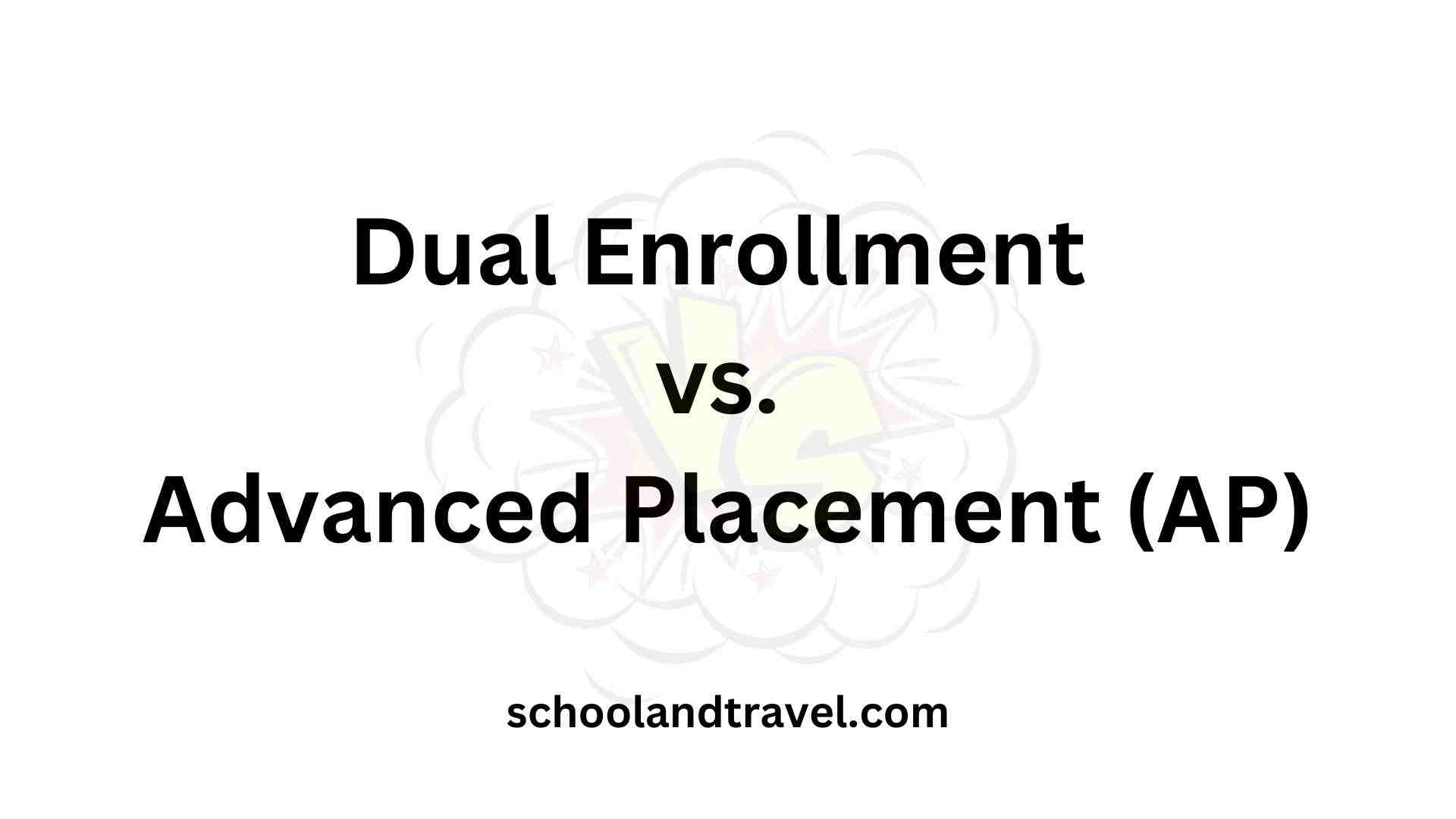In today’s competitive educational landscape, high school students often seek opportunities to enhance their education and prepare for college.
Two popular options that provide such opportunities are dual enrollment and Advanced Placement (AP) programs.
This article will explore these aspects in detail, comparing dual enrollment and AP programs to help individuals make educated choices based on their unique goals, academic strengths, and resources.
What is Dual Enrollment?
Dual enrollment refers to a program that allows high school students to enroll in college-level courses and earn credit simultaneously for both high school and college.
Through dual enrollment, students can experience the academic rigor of college while still attending high school.
College-approved instructors can teach these courses alongside high school or college students.
Dual enrollment programs are typically offered in partnership between high schools and colleges or universities.
What is Advanced Placement?
The nonprofit College Board created the Advanced Placement (AP) program, which consists of a curriculum and examination system.
The College Board has developed a standardized curriculum for AP courses, which are demanding, college-level courses offered in high schools.
These courses cover various subjects, including mathematics, sciences, English, history, languages, and more.
AP courses are designed to allow students to engage in academically challenging coursework that mirrors the content and expectations of introductory college courses.
Purpose and Benefits of Dual Enrollment
Dual enrollment programs serve various purposes and benefit high school students.
Here are some essential purposes and benefits of dual enrollment:
1. College Credit:
One of the primary purposes of dual enrollment is to allow students to earn college credit while still in high school.
Students can accumulate credits that may be transferable to colleges and universities by completing dual enrollment courses.
This shortens the time required to complete a bachelor’s degree and reduces the overall cost of higher education.
2. College Experience:
Dual enrollment allows students to experience college-level coursework and the academic expectations of higher education.
By participating in classes taught by college-approved instructors or taking courses on college campuses, students can gain valuable insight into the learning environment, teaching methods, and classroom dynamics of post-secondary education.
3. Cost Savings:
Dual enrollment can lead to significant cost savings for students and their families.
By earning college credits during high school, students can reduce the number of courses they need to take in college, potentially lowering tuition expenses.
Dual enrollment courses are often offered at a reduced cost compared to regular college tuition rates, making higher education more accessible and affordable.
4. Flexibility:
Dual enrollment programs offer flexibility in course selection. Students can explore various subjects and delve deeper into areas of interest.
This flexibility allows students to align their dual enrollment coursework with their academic and career goals, providing a more tailored and comprehensive educational experience.
5. Enhanced Academic Preparation:
Dual enrollment courses are typically rigorous and academically challenging, providing students with higher college preparation.
The coursework and expectations mirror those of introductory college courses, helping students develop critical thinking, problem-solving, and time management skills.
Engaging in college-level coursework during high school can better equip students for the demands of post-secondary education.
Purpose and Benefits of Advanced Placement (AP)
The Advanced Placement (AP) program serves various purposes and benefits high school students.
Here are some essential purposes and benefits of AP:
1. College Credit:
One of the primary purposes of AP is to allow students to earn college credit while still in high school.
Many colleges and universities grant credit or advanced standing to students who earn qualifying scores on AP exams.
This allows students to bypass introductory-level courses in college, potentially saving time and money on their path to obtaining a degree.
2. College-Level Rigor:
AP courses are designed to emulate the content and rigor of college-level coursework.
By participating in AP, students experience a higher level of academic challenge and gain exposure to the depth and complexity of college subjects.
Engaging with advanced material and rigorous coursework prepares students for the academic demands they will encounter in college.
3. Standardized Curriculum:
The College Board developed a standardized curriculum for the AP program.
Ensuring students across different high schools and regions can access a consistent and rigorous educational experience.
The standardized curriculum also provides a standard benchmark for colleges and universities when evaluating students’ academic preparation.
4. Exam-Based Assessment:
AP courses culminate in AP exams, which the College Board administers.
These exams assess students’ understanding of the course material and ability to apply their knowledge.
Colleges can grant college credit to students based on their scores if they take the Advanced Placement (AP) test in a subject.
5. Preparation for College Success:
AP courses enhance students’ academic skills and readiness for college.
They promote critical thinking, analytical reasoning, and problem-solving abilities.
By engaging with challenging coursework, students develop valuable skills that are highly valued in college and beyond.
Program Availability and Requirements for Dual Enrollment
The availability and requirements for dual enrollment programs may vary depending on the institution and the partnership agreements between high schools and colleges or universities.
Here are some common factors to consider regarding program availability and requirements for dual enrollment:
1. Eligibility Criteria:
Dual enrollment programs typically have specific eligibility criteria that students must meet to participate.
These criteria may include minimum GPA requirements, grade level (often a junior or senior year), and standardized test scores (e.g., SAT or ACT).
Some programs may also consider a student’s maturity, readiness for college-level coursework, and recommendations from high school teachers or counselors.
2. Course Options:
Dual enrollment programs usually offer various course options across different subject areas.
These courses include mathematics, sciences, English, history, and languages.
The specific courses available may depend on the partnership agreements between the high school and the college or university.
3. Institutional Partnerships:
Dual enrollment programs are often established through partnerships between high schools and local colleges or universities.
These partnerships determine the courses available, instructional methods, and transferability of credits.
Students need to research the institutions participating in the dual enrollment program and understand the credibility and transferability of the credits earned.
4. Application Process:
Dual enrollment programs typically have an application process that students must complete.
This process may include submitting an application form, providing transcripts, meeting with a high school counselor, and taking placement exams to assess readiness for college-level coursework.
Program Availability and Requirements for Advanced Placement (AP):
The Advanced Placement (AP) program is widely available in high schools nationwide and internationally.
Here are some key aspects to consider regarding program availability and requirements for AP:
1. Course Availability:
AP offers various courses in mathematics, sciences, English, history, languages, and social sciences.
The availability of specific AP courses may vary from school to school based on factors such as student demand, teacher expertise, and resources.
2. Prerequisites:
Most AP courses do not have specific prerequisites, allowing students to enroll in the courses of their choice.
However, some AP courses, particularly in subjects like mathematics and sciences, may recommend or require prior knowledge or completion of related coursework.
For example, it is common for students to take an introductory course in a subject before enrolling in the corresponding AP course.
Students should check the specific prerequisites or recommendations for the AP courses they are interested in.
3. Examination Requirements:
The AP program culminates in AP exams administered by the College Board.
While participation in AP courses does not require taking the corresponding AP exams, students are encouraged to do so to demonstrate their mastery of the course material and potentially earn college credit.
It’s important to note that taking AP exams incurs an additional fee, and students need to register for the exams during the designated registration period.
4. High School Enrollment:
Students generally need to be enrolled in a high school that offers AP courses to participate in AP.
The availability of AP courses may vary depending on the size and resources of the high school.
Some schools may have a wide range of AP courses, while others offer a more limited selection.
Frequently Asked Questions (FAQs) on ‘Dual Enrollment vs AP’
Dual enrollment involves enrolling in college-level courses while still in high school, earning high school and college credit. On the other hand, AP offers college-level courses taught in high school, and students can take AP exams to earn college credit.
Yes, both Dual Enrollment and AP offer the opportunity to earn college credit.
Dual Enrollment and AP are generally recognized and accepted by colleges and universities.
Both Dual Enrollment and AP offer rigorous coursework at the college level.
Conclusion
The choice between Dual Enrollment and Advanced Placement (AP) depends on individual preferences, academic goals, and the specific offerings at a high school.
Dual enrollment allows students to enroll in college-level courses while still in high school, earning both high school and college credit.
Awesome one; I hope this article answers your question.
Editor’s Recommendations:
- Is AP Spanish Worth It? (Meaning, Worth, FAQs)
- Homeschool Spanish Academy (Features, FAQs)
- 40 Top Duolingo Languages You Can Learn Easily (FAQs)
- Is AP World History Hard? (FAQs)
- 5 Best Ivy League Universities In Canada (Req., FAQs)
If you find this article good, please share it with a friend.





